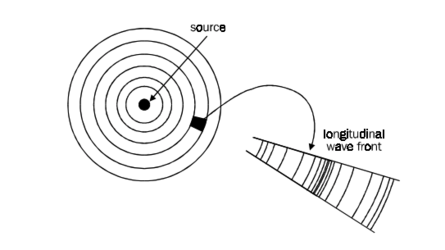Free field (acoustics)
Topic: Physics
 From HandWiki - Reading time: 2 min
From HandWiki - Reading time: 2 min
In acoustics, a free field is a situation or space in which no sound reflections occur.[1][2]
Characteristics
The lack of reflections in a free field means that any sound in the field is entirely determined by a listener or microphone because it is received through the direct sound of the sound source. This makes the open field a direct sound field.[3] In a free field, sound is attenuated with increased distance according to the inverse-square law.[1]
Examples and uses
In nature, free field conditions occur only when sound reflections from the floor can be ignored, e.g. in new snow in a field, or approximately at good sound-absorbing floors (deciduous, dry sand, etc.) Free field conditions can be artificially produced in anechoic chambers. In particular, free field conditions play a major role in acoustic measurements and sound perception experiments as results are isolated from room reflections.
With voice and sound recordings, one often seeks a condition free from sound reflections similar to a free field, even when during post-processing specifically desired spatial impression will be added, because this is not distorted by any sound reflections of the recording room.
In the simple example shown in Figure 1, a singular sound source emits sound evenly and spherically with no obstructions.[1]
Equations
The sound intensity and pressure level of any point in a free field is calculated below, where r (in meters) is the distance from the source and "where ρ and c are the air density and speed of sound respectively.[1]
[math]\displaystyle{ p^2=\rho c I= \rho cW/4\pi r^2 }[/math] [1]
To calculate for air pressure, the equation can be written differently:[1]
[math]\displaystyle{ L_p=L_w + 10\log_{10} (\rho c/ 400) - 10\log_{10} ( 4 \pi r ^2 ) }[/math] [1]
In order to simplify this equation we can remove elements:[1]
[math]\displaystyle{ L_p=L_w - 10\log_{10} ( 4 \pi r ^2 ) }[/math] [1]
Measuring the sound pressure level at a reference distance (Rm) from the source allows us measure another distance (r) more easily than other methods:[1]
[math]\displaystyle{ {\displaystyle L_{p}=L_{m}-20\log _{10}(r/ r_m)} }[/math] [1]
This means that as the distance from the sources doubles, the noise level decreases by 6 dB for each doubling. However if the sound field is not truly free of reflections, a directivity factor Q will help "characterise the directional sound radiation properties of a source."[1]
References
- ↑ 1.00 1.01 1.02 1.03 1.04 1.05 1.06 1.07 1.08 1.09 1.10 1.11 Hansen, Colin (January 1951). "FUNDAMENTALS OF ACOUSTICS". American Journal of Physics. https://www.who.int/occupational_health/publications/noise1.pdf.
- ↑ Ray, Elden (16 June 2010). "INDUSTRIAL NOISE SERIES Part IV MODELING SOUND PROPAGATION". https://www.lrl.mn.gov/docs/2015/other/150681/PFEISref_2/Ray%202010.pdf.
- ↑ "sound fields - acoustic glossary". https://www.acoustic-glossary.co.uk/sound-fields.htm#:~:text=Direct%20Sound%20Field%20is%20the,the%20source%20alone%20without%20reflections..
See also
 |
 KSF
KSF
